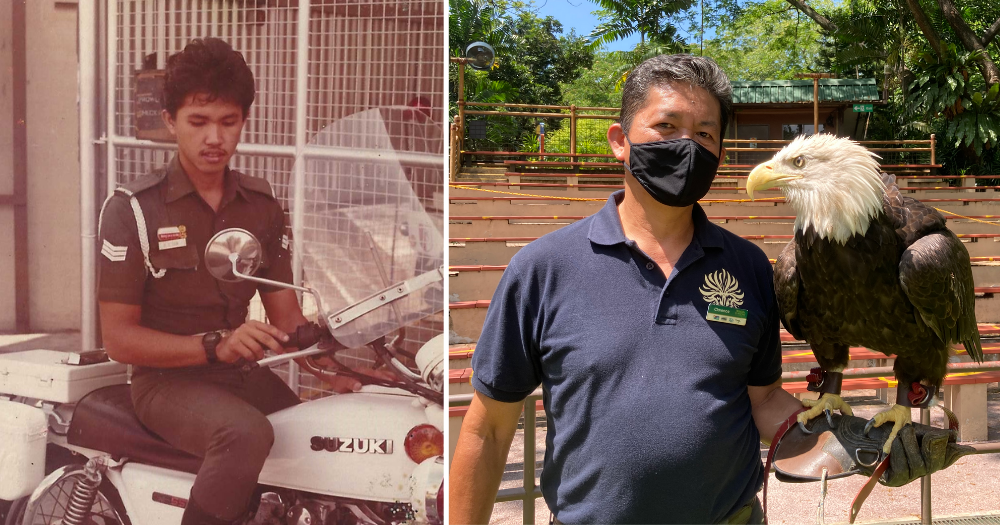"Maybe you should stand back a bit."
"Oh okay sure," I said as I inched back warily towards the metal railing at the edge of the grassy plain, phone ready in my hands.
The intended subject of my shot was currently positioned on the arm of a staff member at the other end of the arena, and at the sight of an almost imperceptible flick of a hand, swooped over to land perfectly on Clarence Saw's arm.
Despite me standing more than two metres away, the gust of wind from the powerful flap of the bald eagle's wings riffles my hair.
Saw, who has been working as a trainer for birds of prey at the Jurong Bird Park for the last 33 years, and who is now the senior manager of Animal Presentations, swivels around for me to get an eyeful of the magnificent avian.
Unpredictable creatures
The bald eagle, whose name is Suzy, finishes gobbling up the small chunk of meat treat after accomplishing its trick, and proceeds to nip at Saw's forearm, leaving marks on his skin.
The 58-year-old however, remains unperturbed and barely flinches, his experience in handling the bird (and be on the receiving end of such treatment) evident.
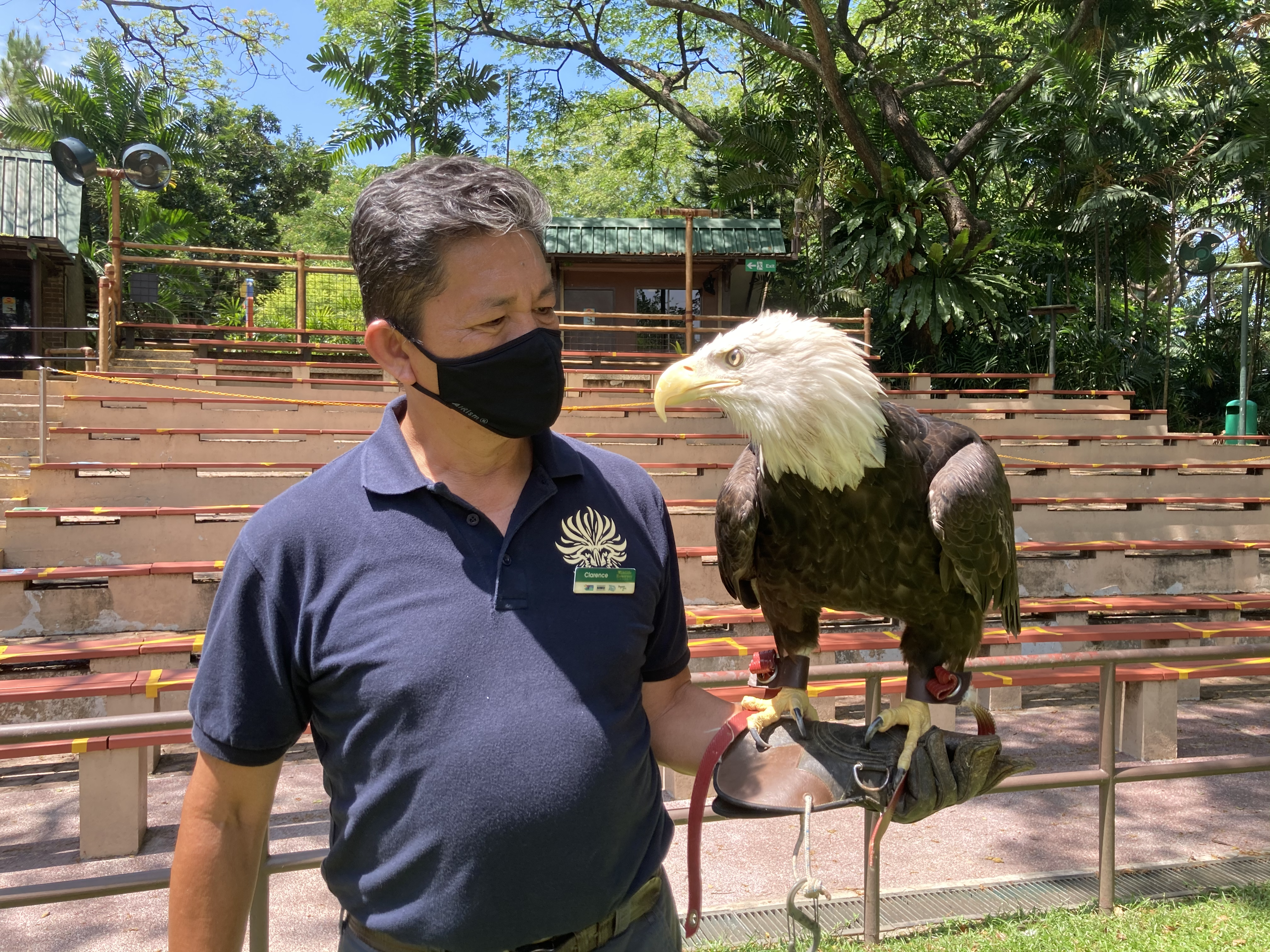 Photo by Ashley Tan
Photo by Ashley Tan
But having cared for and trained raptors, as well as worked as a presenter in the hawk shows — now known as the King of the Skies show — alongside the raptors for nearly half his life, Saw understands that the birds' compliance to tricks belies their unpredictability.
"You can train them, but over the years I've realised you can't tame them," he said.
These birds of prey, which include hawks, eagles, falcons and vultures, retain their natural instincts and can pose a formidable threat. My eyes catch sight of Suzy's talons, which dig into Saw's arm, currently sheathed in a protective gauntlet.
I repress the urge to stroke its feathers like one does to a pet bird, and yet, feel a healthy amount of respect for this being whose intelligence shines clearly in its ochre eyes.
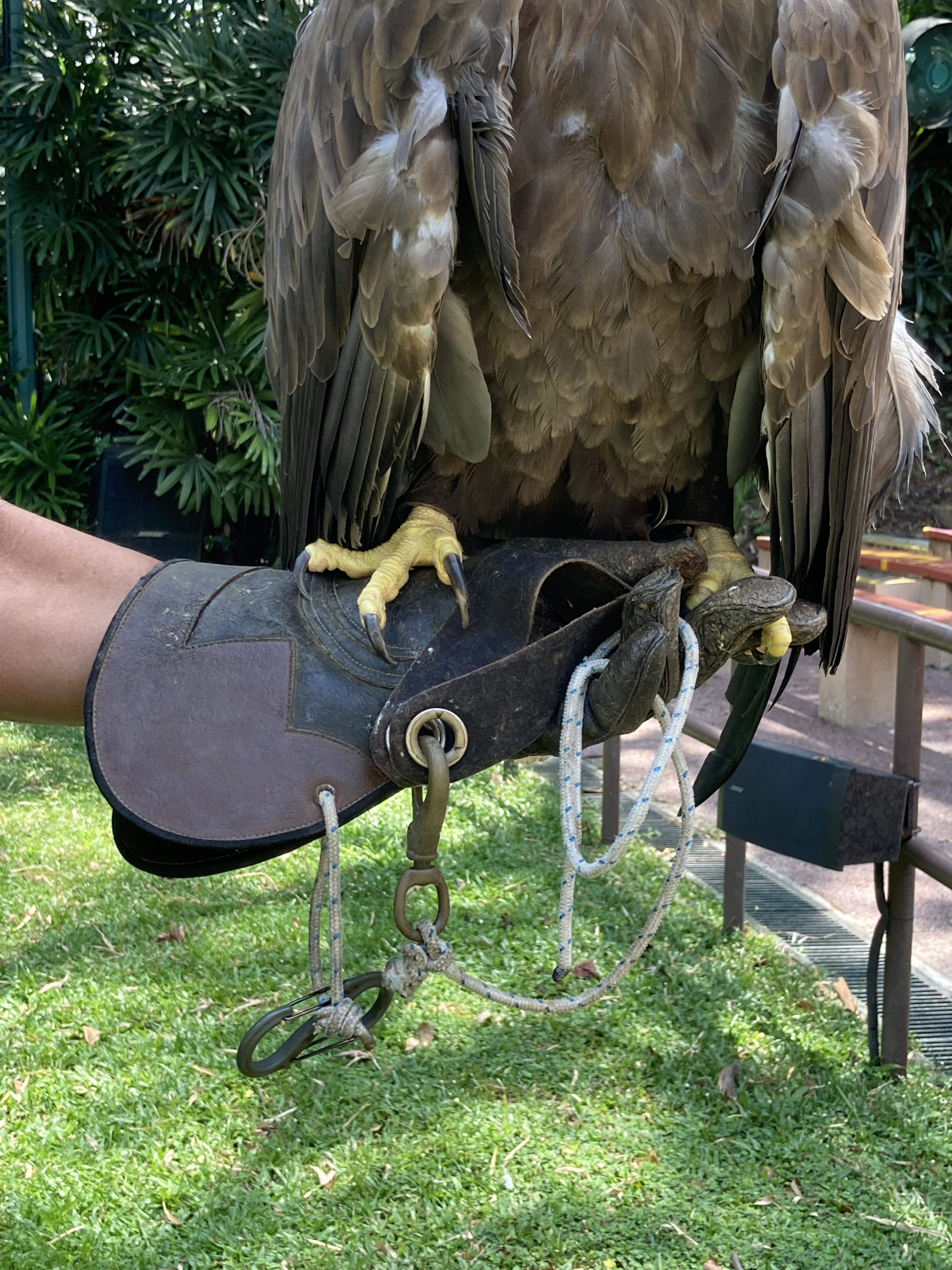 Look at those long talons. Photo by Ashley Tan
Look at those long talons. Photo by Ashley Tan
Former military policeman
Saw handles the birds with ease and familiarity, and with his salt and pepper hair, and tan, weathered face, the man looks truly at home in the outdoors.
Surprisingly, caring for birds of prey was the last thing he expected when he left his prior job of six years as a military policeman.
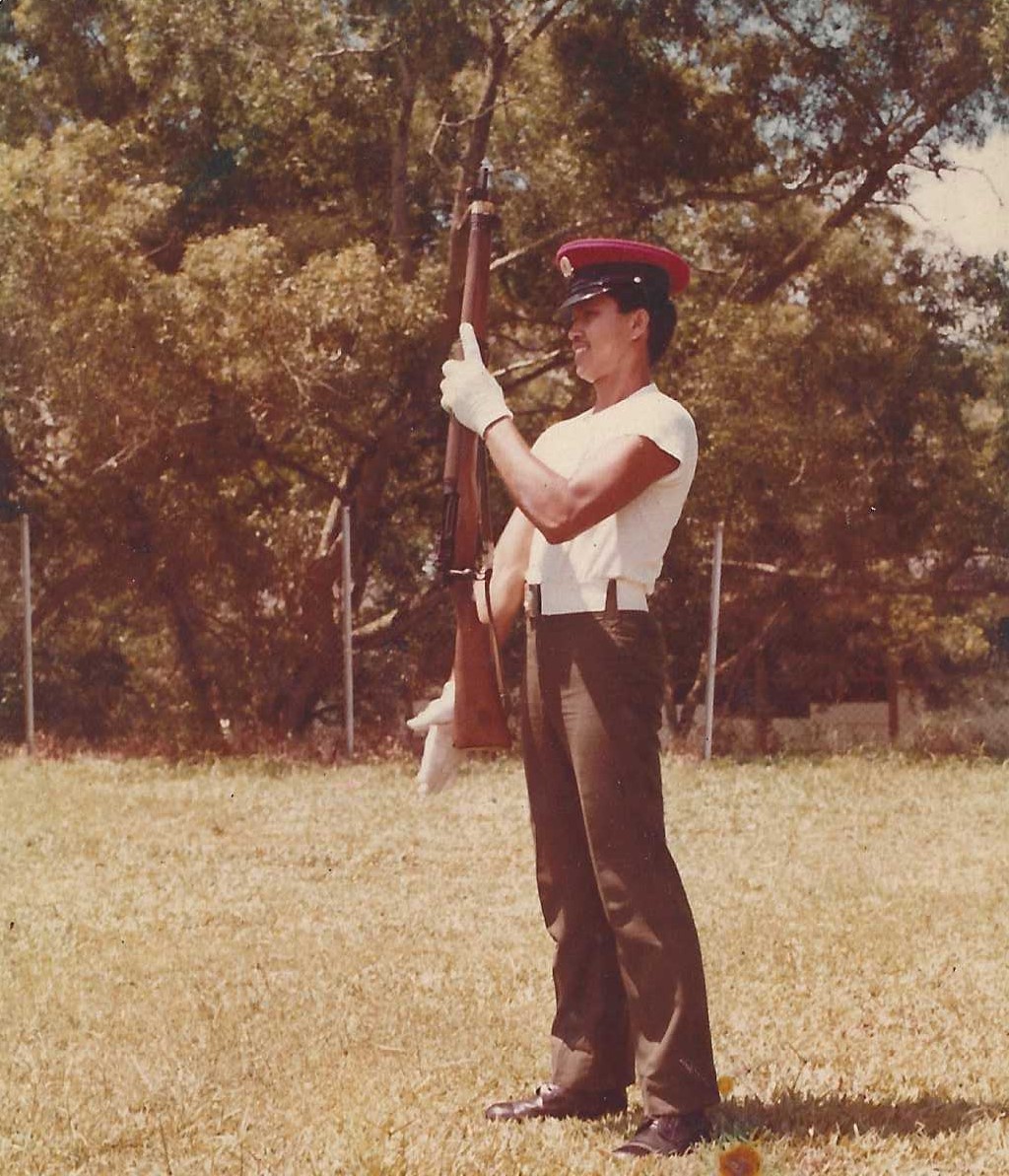 Photos courtesy of Clarence Saw via WRS
Photos courtesy of Clarence Saw via WRS
Back in the army, Saw's duties comprised enforcing law, order and discipline on soldiers and carrying out policing and security operations. However, it was this system and daily discipline that compelled him to switch jobs.
"It was getting too regimented for me. You know how in the army its all about the regiment, the camp. You start at 6am in the morning and at this time you gotta do this, and then after that you gotta perform something else at another time," Saw said of the strict schedule they followed.
In search of more freedom, Saw, aged 25 then, decided to fly the nest.
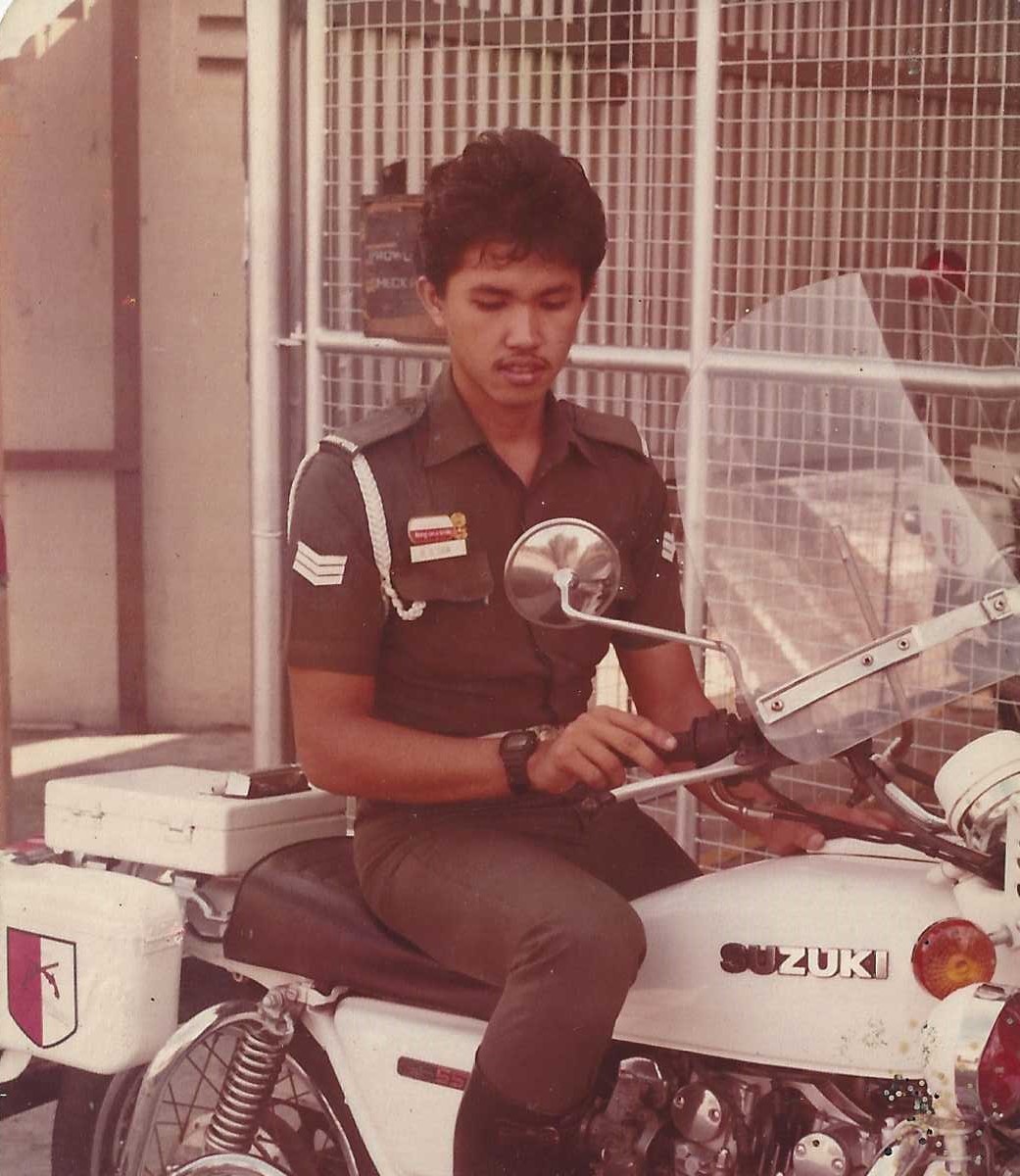 Photos courtesy of Clarence Saw via WRS
Photos courtesy of Clarence Saw via WRS
Assigned to birds of prey on his first day
While searching for a new job, Saw came across an advertisement for a vacancy as a "trainer presenter" at Jurong Bird Park in the Classifieds section of the newspaper. Mind you, this was May 1988 where computers and the Internet were still in their fledgling stages and sites like JobStreet and Glassdoor were a distant dream.
Saw decided to apply for the job without much hesitation: "I was thinking, hmmm, maybe I'll give it a go since I already have some interest in birds."
This interest was sparked by his father, who returned home one day when 16-year-old Saw was watching television, with a cage containing a tiny Oriental White-eye, a popular songbird.
It was the first time he had seen such a bird, and Saw initially paid it no mind. As time went by, one songbird became two, and then three, and Saw soon found his home filled with more than 10 birds chirping and twittering.
He gradually became involved in the care of the birds, helping to feed and bathe them and clean their cages.
Despite the experience Saw had (somewhat), in no way did he expect to graduate from caring for cute songbirds to be assigned the fearsome birds of prey on his first day of work.
"On the day that they told me to start work, they brought me down to this place [at Jurong Bird Park], and told me this will be where I'll be working and what I'll be taking care of, it came like a surprise and a shock to me. At no point at all did I expect I would be working with the largest [birds]."
It was his first time encountering birds of prey as well, and Saw described the mixed feelings he had at this new revelation — "I was excited, but also at the same time, you know, wah, can I do this or not?"
'Just you and the bird'
He needn't have worried much — Saw went through plenty of training to get him accustomed to his new and unconventional job.
Although he was "a bit intimidated at the start", he assured that all keepers and presenters are trained on how to handle the creatures carefully.
"We were told the consequences of what will take place if we don't handle them properly... I mean, they've got powerful beaks, powerful feet," Saw said, alluding to the potential for injuries to occur.
To overcome that barrier of fear, newbies like Saw would literally sit down (at the exact amphitheatre I interviewed Saw at) for several hours with the birds perched on their arms, as part of a training procedure called manning.
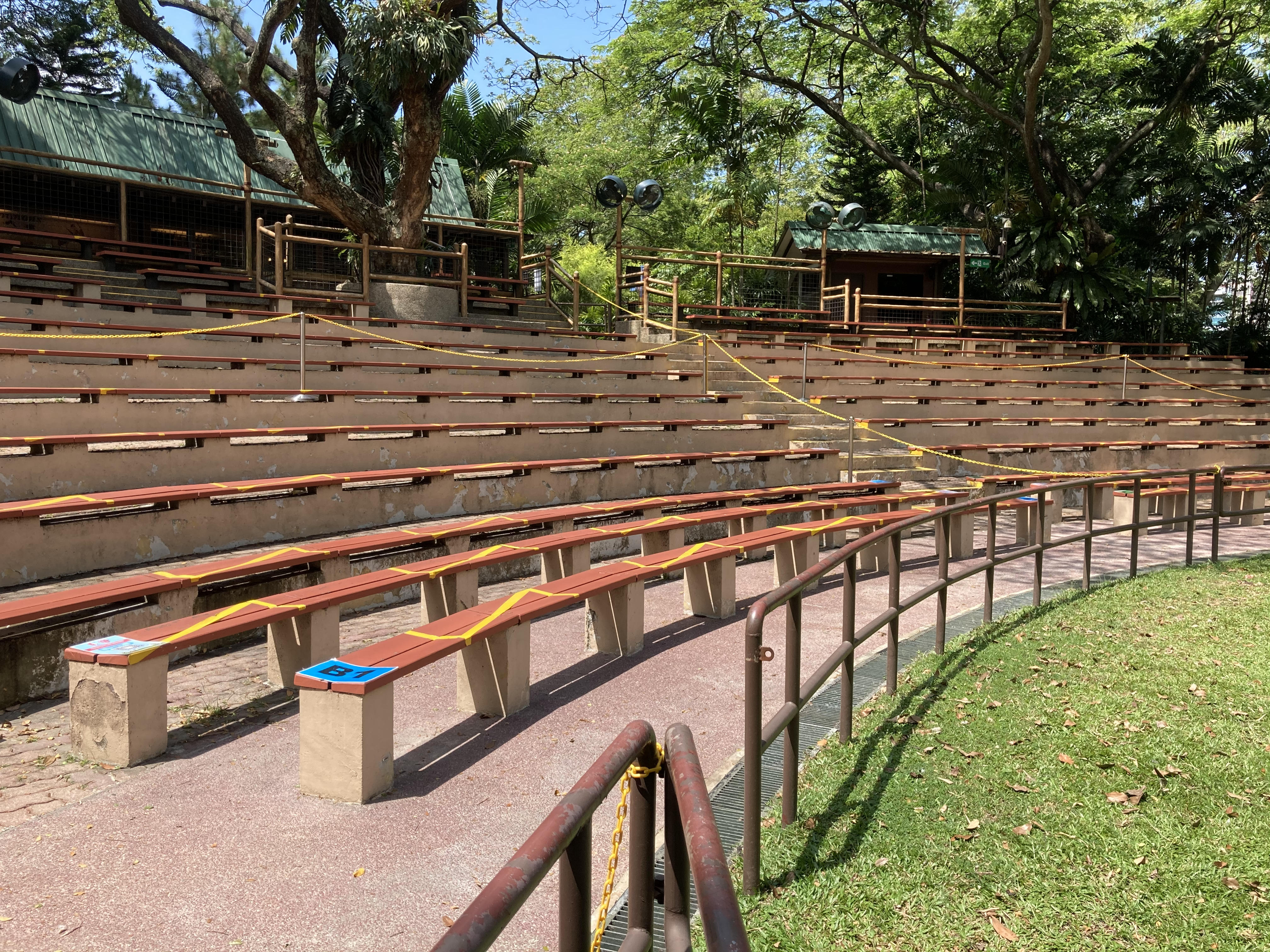 The amphitheatre where the shows take place. Photo by Ashley Tan
The amphitheatre where the shows take place. Photo by Ashley Tan
This was to build a relationship between the trainer and the raptor — for the former to familiarise themselves with the heft of the bird in their arms (a bald eagle like Suzy can weigh up to 6.3kg), and for the birds to be comfortable with a new human's presence.
"It's really just sitting there, and then it's just you and the bird."
Very cozy.
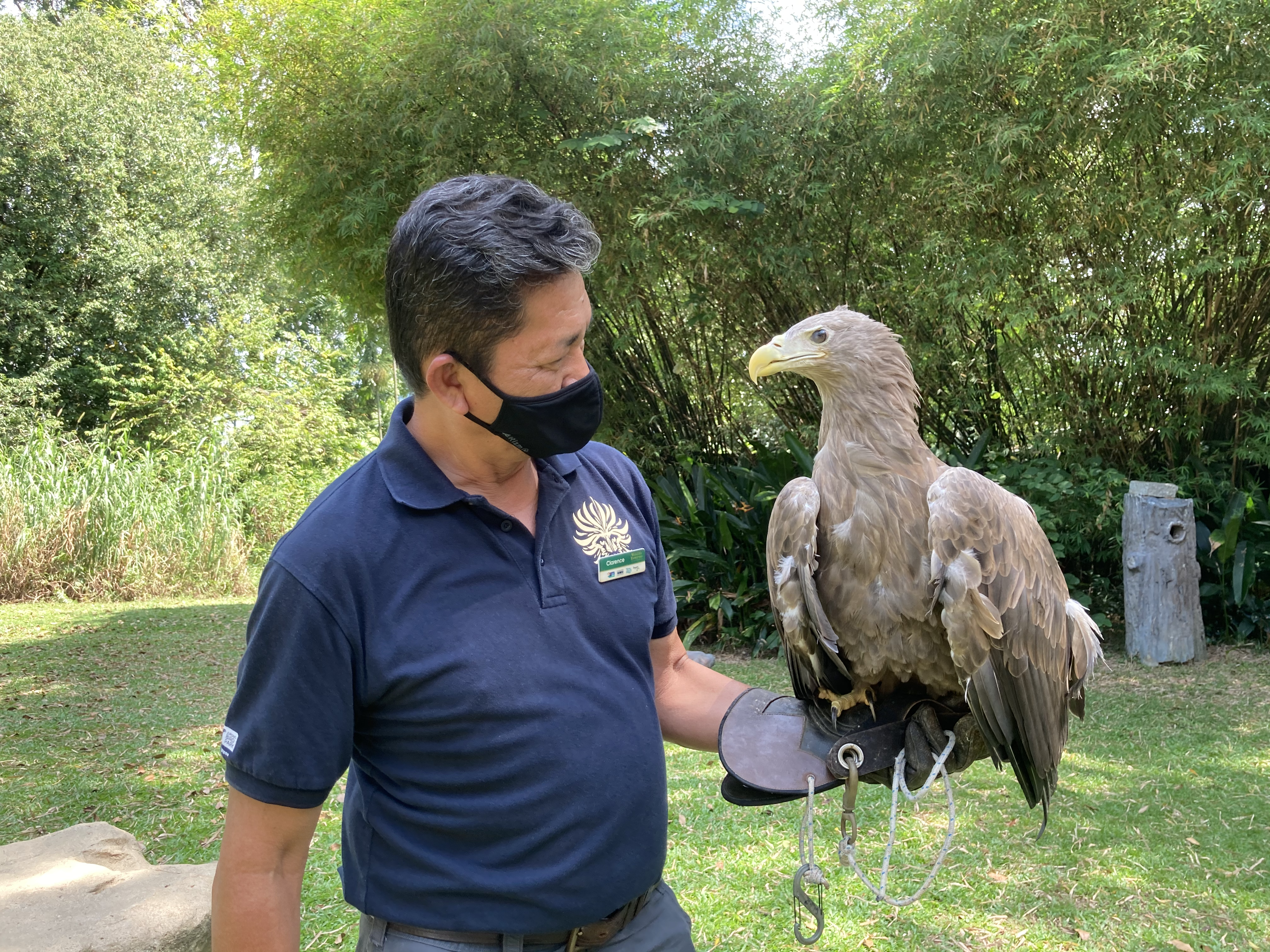 Photo by Ashley Tan
Photo by Ashley Tan
The true stars of the show
As the then-hawk show had just opened the same year he started working at Jurong Bird Park, Saw was one of the pioneer presenters there.
At the time, there were only six birds of five different species starring in the show, as compared to the numerous individuals seen in the Kings of the Skies shows these days. Here's a snippet of a recent one.
Prepping to become a presenter was an "intensive" and gruelling process for Saw, due in part to his lack of presentation skills and experience in the field.
He cited the task of having to handle the birds, presenting from a script, and working the crowd concurrently, as one of the biggest challenges he faced during his probation period, which was a lengthy six months.
Thankfully, he passed his probation with flying colours, and Saw has gone on to present for hundreds of people, even esteemed ones like the former President of Singapore S. R. Nathan, the late Lee Kuan Yew and Prime Minister Lee Hsien Loong.
Despite the high-flying decades spent on stage, Saw retains no delusions of grandeur about who truly dominates the shows.
"Sometimes you think you come out here and present a show, it's very glamourous and all that. But I always instil this mindset in my staff that we are not out here to be the stars. The birds are the stars. We are just out here to make the birds look better."
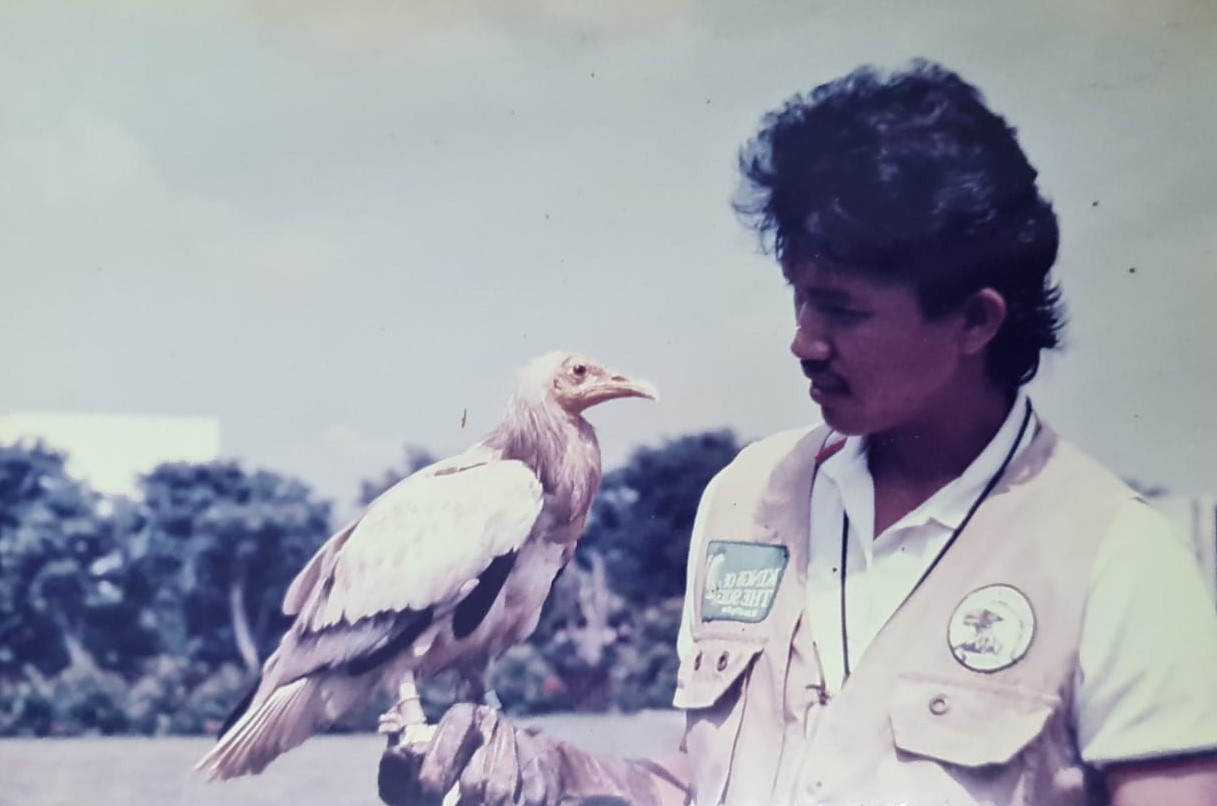 Photos courtesy of Clarence Saw via WRS
Photos courtesy of Clarence Saw via WRS
Being a trainer and presenter also requires a keen sense of intuition and understanding of the birds on an individual basis, Saw reveals.
Working with birds is akin with navigating real life, human relationships, and Saw explains that even birds of the same species have different personalities.
"This bird may be very comfortable, you're stroking and touching it, it's fine. But another bird [of the same species] may not like it. So it's like people — I can say things and joke about you but I cannot do it with this other person because he doesn't like it."
This comes into play during actual shows and performances, and Saw has to be aware of which bird he is handling and the limits he can push with the bird.
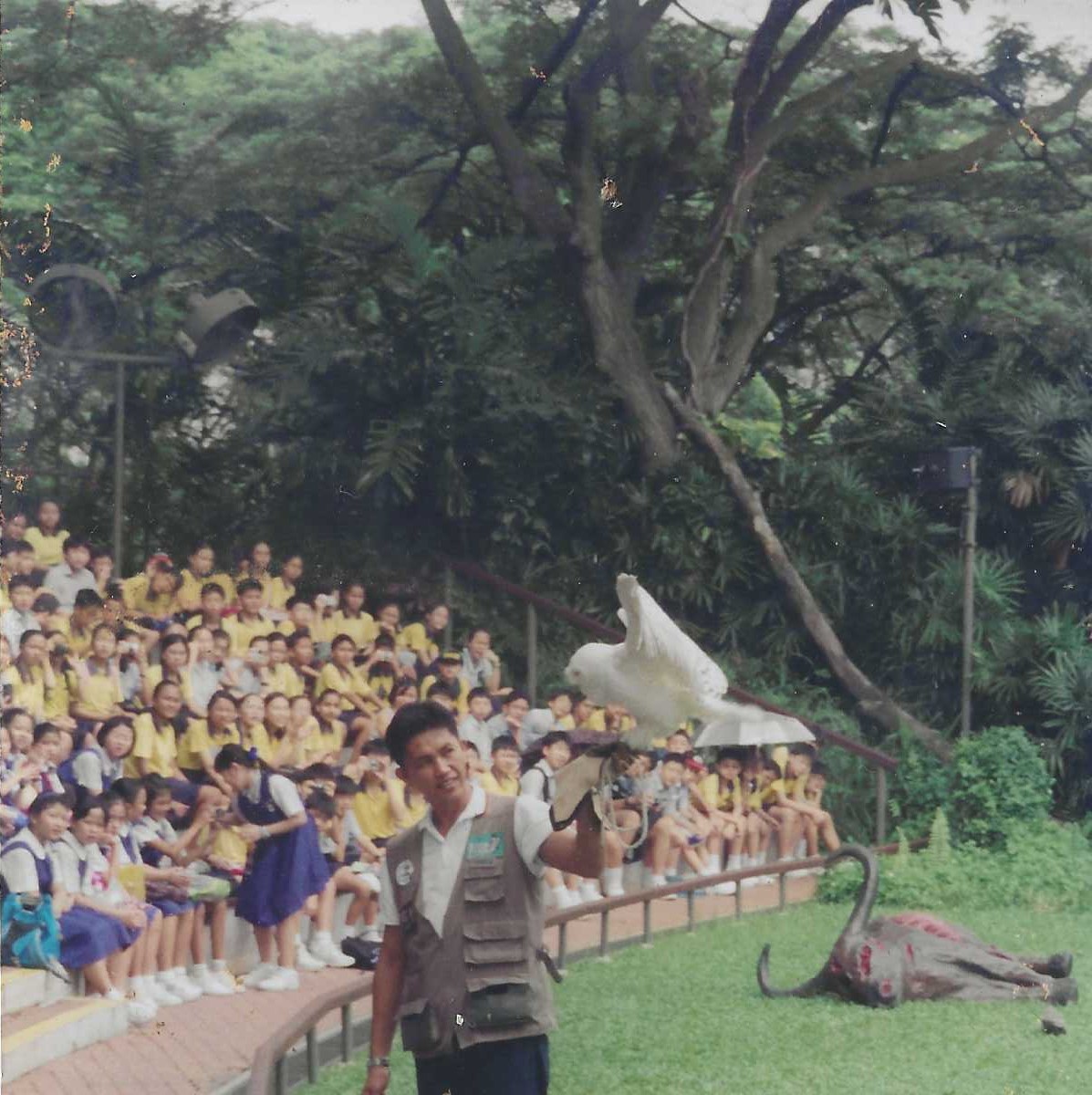 Photos courtesy of Clarence Saw via WRS
Photos courtesy of Clarence Saw via WRS
Hunting down an escapee falcon
While Saw's new career might have gotten off to a flying start, things were not always smooth sailing.
One particular memorable incident (for perhaps both the right and wrong reasons), which took place a few years after Saw started working, was when a laggar falcon took off midway during a show Saw was conducting.
Falcons were part of the hawk show, and presenters would swing a long lure round and round, much like Mongolian falconers seen in documentaries who hunt game on horseback. The birds would then twirl in the air and dive for the lure, making for a rather thrilling experience for the audience.
Unfortunately on that fateful day, the laggar falcon did not perform as expected.
"This falcon just went straight, and straight, and straight until we lost sight of it."
One can imagine the bafflement the audience that day likely felt. Saw sheepishly reveals that he felt a certain amount of panic in that moment, but at the same time, excitement that he would be venturing out on this "wild goose chase".
With the help of a tracking device, which were attached to all falcons back then, Saw and other staff slowly and labouriously pursued the escapee bird all the way to Keppel Shipyard, which is around 8km away from Jurong Bird Park.
This process was complicated by the fact that the transmitter signal from the tracking device would bounce off buildings, misdirecting the group and causing them to go round in circles. By the time the laggar falcon was retrieved, it was around 10pm.
Saw however, merely sees this as occupational hazard and a learning point.
"Things like this happen you know, and its part and parcel of the job."
"I tell my staff not to always think that, even though the birds perform everyday... It doesn't mean that it's going to be smooth all the time. Along the way there will always be some other things distracting them, you know, so we have to be prepared for the unexpected."
There are no longer any falcons at Jurong Bird Park — partly due to this incident, as well as the lack of space to accommodate the range and speed at which they fly.
A bond with a special bird
Saw also elaborated on a certain unique relationship he had with... surprise, surprise, an Andean condor. Andean condors are a species of vulture from South America, and this individual in particular was named George.
It is a no-no for any one bird to become too attached to a trainer, and vice versa. Saw explains that this would complicate things should the bird not want to be handled, fed, trained or cared for by any other people.
"Even though there is some affection on the bird, but because it's the nature of our job, we have to realise that these are wild animals, we cannot treat them as a pet," Saw said.
And yet, it's clear that Saw has a certain bond with George. He describes George fondly as a "very special bird". Its most distinctive characteristic is its massive size — the Andean condor is the largest flying bird in the world by combined measurement of weight and wingspan, up to 15kg and 3.5m respectively.
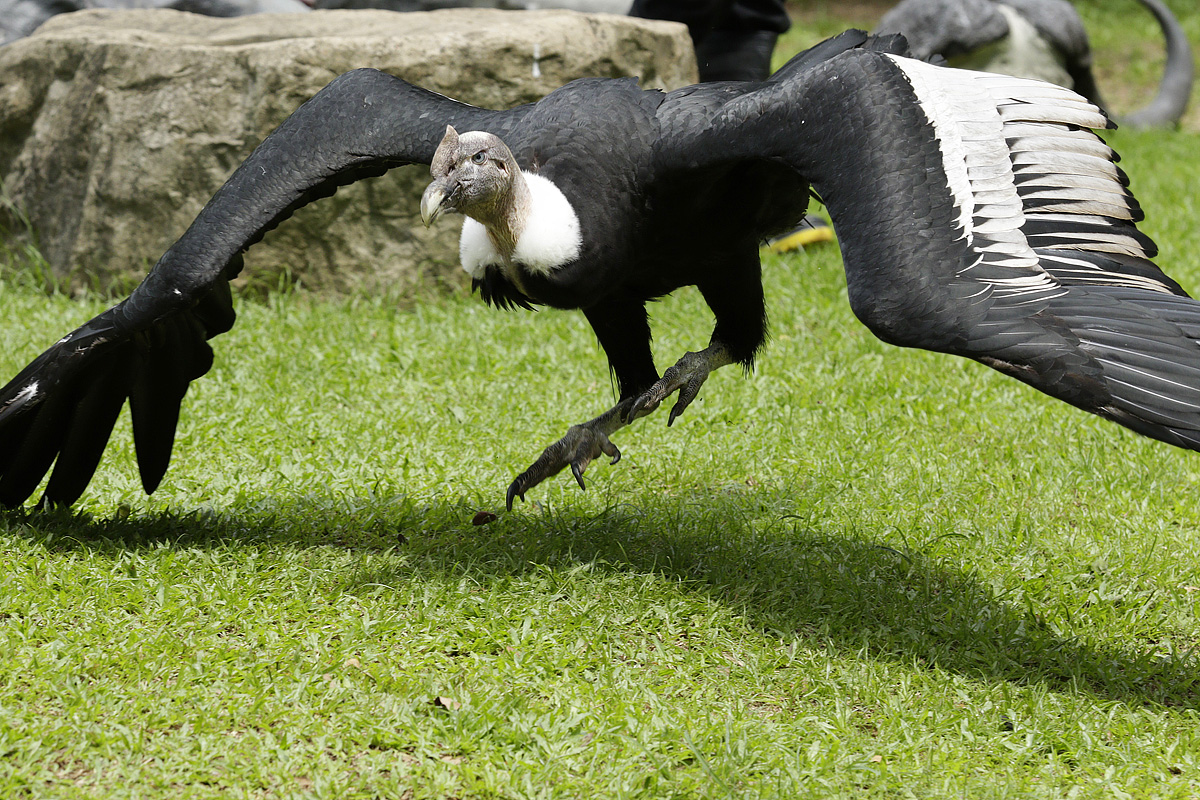 George the Andean condor. Photos courtesy of WRS
George the Andean condor. Photos courtesy of WRS
Despite his size, which intimidated quite a few keepers, Saw came to know of George as a gentle giant who was very calm and "doesn't display any aggressiveness".
He wistfully harks back to the days spent with George:
"He's so intelligent, and he picks up things so fast in training. I could actually walk around with him and he'll just walk by my side. He can stop sometimes [while walking] and he'll just stare at something and look around. And I'll just continue walking... and after a few metres away I'll stop and call him 'George!', and he'll gather back his senses and come running back towards you."
Unfortunately, George died in 2018 due to medical complications, and having worked with him since the 1990s, Saw greatly misses the gigantic bird.
"It's part and parcel I guess, in this line of work. You have to accept that they come, they go. After some time you get used to it."
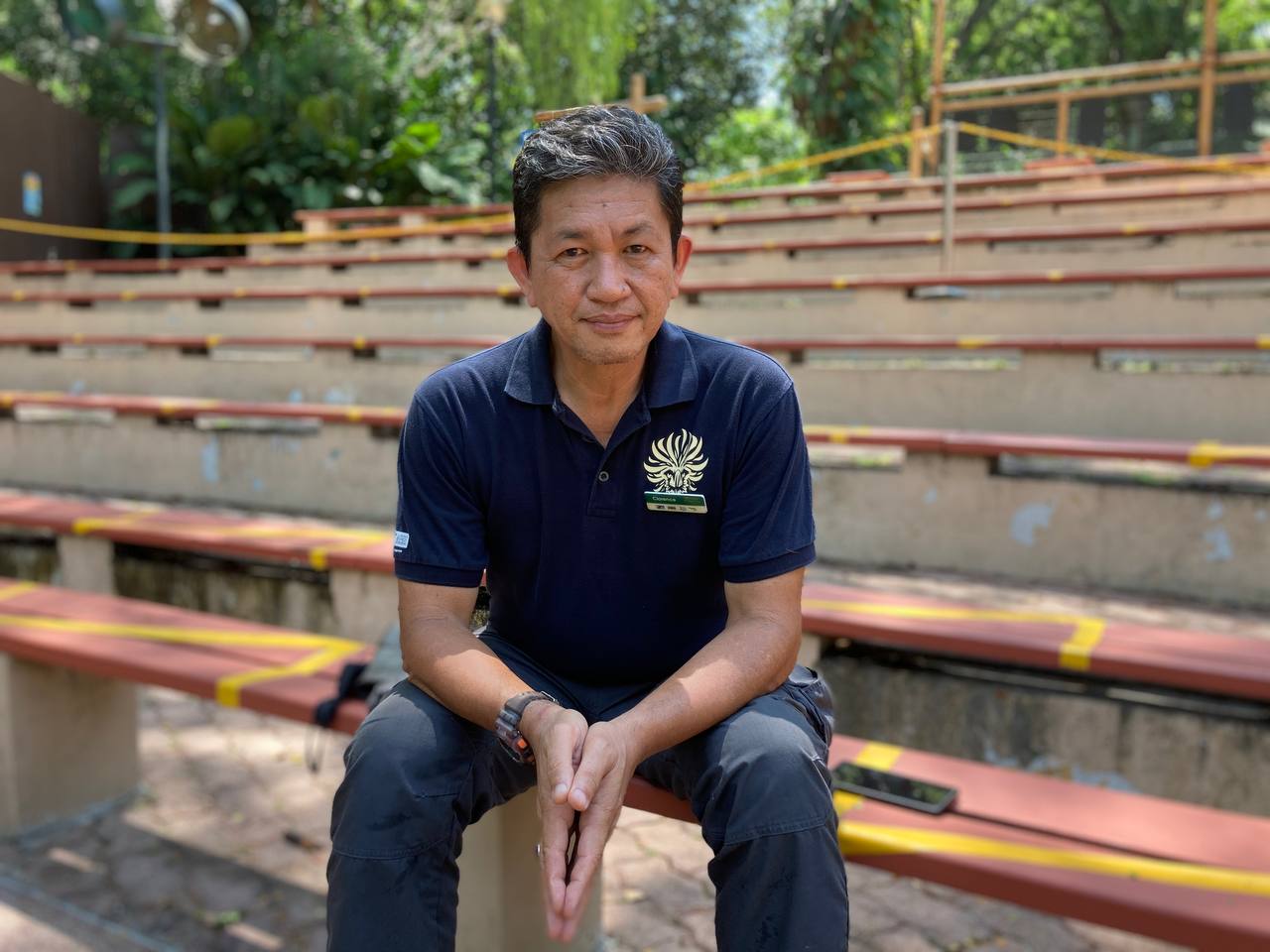 Photo by Ashley Tan
Photo by Ashley Tan
Never thought of switching careers
After being a presenter for 28 years, Saw has since taken a backseat, and is mainly involved in mentoring and training staff to present shows, although he yearns to be back in the limelight — "I would love to [present again]" he chuckles. However, he adds that he has to step aside to give others a chance.
What truly struck me though, was Saw's dedication to the job. After all, he has never considered switching careers throughout his impressive 33 year stint at Jurong Bird Park.
"The kind of things that I do, I will not be able to do it anywhere else. I mean where else will I be able to work outdoors, which I love so much, be with birds I admire and until today, am still learning from. I'm not the kind of 'behind the desk' person."
"I look forward to coming to work everyday," Saw reveals. The unpredictable nature of the birds of prey also adds that element of fun and excitement, which he views as a new challenge.
This is in stark contrast to those who are caught up in a constant pursuit of happiness or career milestones.
Although Saw might be getting on in years, he has no plans to retire anytime soon, patting his thighs and proclaiming that he will continue working for as long as his legs allow.
When asked what he will miss most about Jurong Bird Park, as the bird park is scheduled for a relocation to its new premises at Mandai next year, Saw is unable to provide an answer.
This is perhaps, telling in and of itself — after all, the greatest attachments to and the best memories Saw has of his job are of the birds he cares for, and less so of any physical area within the park.
And maybe for Saw, who was unexpectedly thrust into this role, this is his greatest achievement — to love one's job so much that time simply flies by.
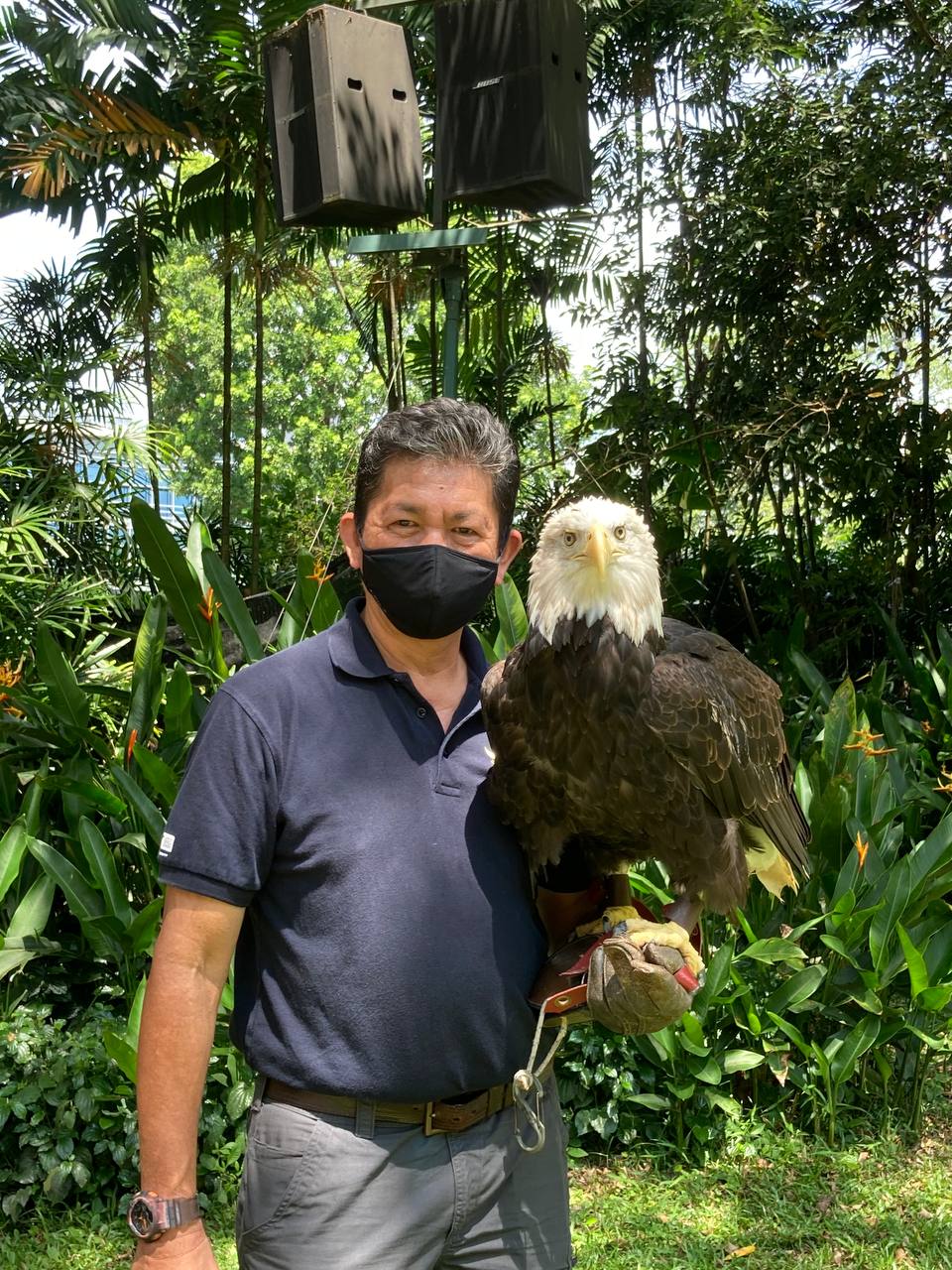 Photo by Ashley Tan
Photo by Ashley Tan
Stories of Us is a series about ordinary people in Singapore and the unique ways they’re living their lives. Be it breaking away from conventions, pursuing an atypical passion, or the struggles they are facing, these stories remind us both of our individual uniqueness and our collective humanity.
Top photo courtesy of Clarence Saw and by Ashley Tan
If you like what you read, follow us on Facebook, Instagram, Twitter and Telegram to get the latest updates.
